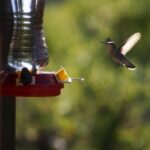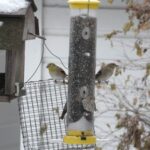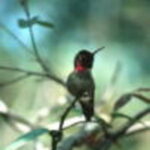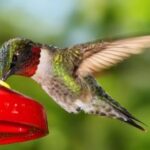Hummingbirds eat 90 percent plant nectar and ten percent of insects for protein, according to the National Audubon Society. Since more land and nectar-bearing flowers are being lost to development, migrating hummingbirds are becoming more reliant on feeders to get the calories they need. Many people think they can put up one hummingbird feeder and keep on refilling it when it’s empty. But keeping a hummingbird feeder is not as simple as that.
Feeders are often bright red in order to look like flowers and attract hummingbirds. But they also attract problems, such as hummingbird fighting, attracting insects and dangerous bacteria.
Feeder Placement
Do not place just one hummingbird feeder in a yard or garden or only one pair of hummingbirds will be fed. Put up several small feeders as far apart as possible in order to prevent fights. Hummingbird fights can be to the death. Hummingbirds males will attack any other hummingbird that goes near his personal feeder, but one hummingbird cannot defend several feeders.
Never place a feeder directly in front of a window because the hummer may fly into the windowpane and kill itself. Try to place a feeder in the shade so the artificial nectar does not quickly ferment.
Pest Prevention
Sugar water attracts raccoons and bats. To avoid these nocturnal bats stealing all of the nectar in the feeder from the hummingbirds, take down the feeders each night.
Unfortunately, it is a little more difficult to deter bees and ants. Never use insecticides as on or near a feeder as this will ill the birds. A small moat can drown ants. This can be a commercial ant moat or a soda bottle cap with a small hole drilled in it and threaded onto the same wire holding up the feeder. Ants crawl down the wire to get to the nectar but fall into the moat and drown. Refill the moat as often as possible.
Bees are attracted to the color yellow, so if your feeder has yellow markings, either remove them or paint them with red nail polish. Commercial bee guards made specifically for hummingbirds can be attached, as long as the guards are red. Changing the ratio of the hummingbird nectar to make it less sweet will make it less palatable to the bees. Thomas G, Barns, PhD, of the University of Kentucky. suggests using five cups of water to one cup of white granulated sugar. Never use brown sugar as this contains too much iron for a hummingbird’s body to handle.
Another drastic solution is to vacuum a few of the bees at the feeder. The other bees will take the hint and fly off. The live bees in the vacuum can be released in an area away from the feeder. But you need to be absolutely sure the bees are not Africanized honeybees or “killer bees” or the colony may swarm and sting any people nearby.
Dirty Feeders
Drinking from dirty feeders is akin to eating off of moldy plates. Hummingbirds will drink from dirty feeders and the mold, bacteria or fungi grown on a dirty feeder can kill them. Feeders should be ideally be cleaned before new nectar is added, but once a week in mild weather and twice in hot, humid weather should suffice.
Hummingbirds can be easily poisoned by detergents, soaps or household cleaners. Only clean feeders with vinegar added to hot water. If bleach is used, rinse off the feeder with vinegar and water, not just water, according to the Audubon Society of California. Adding rice grains to the feeder with hot water and vinegar and then shaking the feeder helps to scrub hard-to-reach places.
References
National Adubon Society: Hummingbirds/Nectar Feeders. http://web4.audubon.org/bird/at_home/bird_feeding/hum_feeders.html
Hummingbirds: Hummingbird Feeders. http://www.hummingbirds.net/feeders.html
Audubon California: Feeding Hummingbirds. http://kern.audubon.org/hummer_feeding.htm
University of Kentucky: Hummingbirds, An Attractive Asset to Your Garden. Thomas G. Barns, PhD http://www.ca.uky.edu/agc/pubs/for/for97/for97.htm








